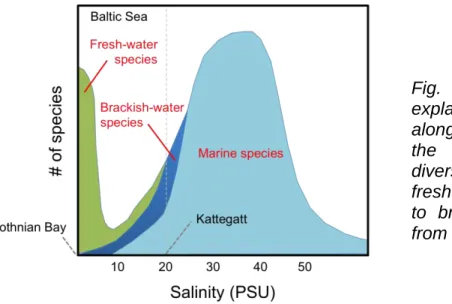First cruise report of POS506, Practical course at sea for students of Biological Oceanography (MNF-bioc-301)
The main aim of our cruise is to investigate horizontal and vertical distribution of abiotic factors as well as planktonic and benthic components along the environmental salinity gradient from the Southwestern Baltic Sea to the Kattegatt and Skagerrak regions. Eight students of the “Biological oceanography” (M.Sc.) course participate in the cruise to receive hands-on training by three staff scientists. During the cruise students collect, sort and analyze data to test whether Remane’s concept of species diversity gradient (Fig. 1) holds for both pelagic and benthic communities.
Abiotic measurement are performed with the CTD, which is deployed at each station before any sampling. Water temperature, salinity, oxygen and other hydrographic measures are recorded along the water column and used to decide depth of sampling for planktonic organisms as well as for general data analysis. During the first leg of the cruise (Kiel-Malmö) we collect plankonic samples at 15 stations using a Bongo net with mesh sizes of 300 and 500 um. Jellyfish samples are measured alive upon sampling as they are not easy to fix, while mesozooplankton and phytoplankton samples are fixed and counted later to estimate abundance and
Fig. 1 – Remane’s concept explains species diversity along the salinity gradient of the Baltic Sea with more diversity in marine and freshwater areas compared to brackish water. (adapted from www.helcom.org)
community composition. At three stations we collect benthic samples using a dredge and a Van Veen grab.
In the early morning of the 30th September, we left Kiel and reached the first station within Kiel Bight at 15:20 in the afternoon to practice with the student preparation and deployment of each device. Here, the students practised communication with the crew and bridge and the casting of the different devices used throughout the cruise, such as CTD, water sampler, Bongo nets, dredge and van veen grab. Students were afterward divided in two groups of four to work in shifts. In each group two students were in charge of preparing and cleaning sampling devices on deck, while the other two communicated with the bridge and the winch, supervised recording of CTD data and filled out the station protocol. All students participated in counting of specimens, data analysis and preparation of a presentation during anchor time in Malmö. So far, 15 stations were casted in total, from which three stations were selected for benthos sampling. We are now on our way to the second sampling block, which will cover the Kattegat and Skagerrak area before processing the samples and data in Gotheburg, Sweden.
